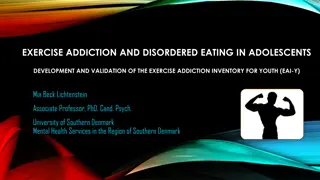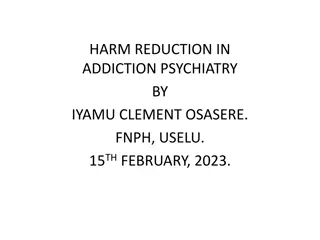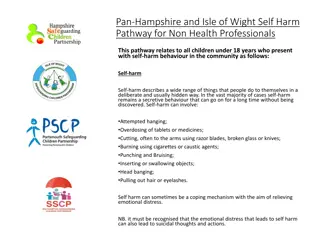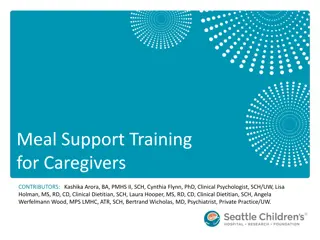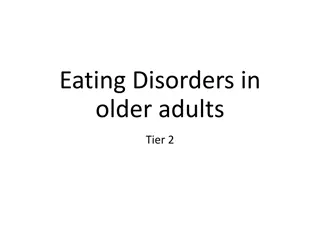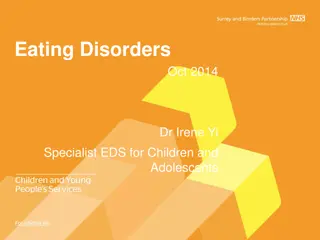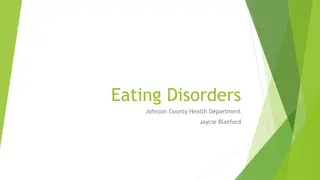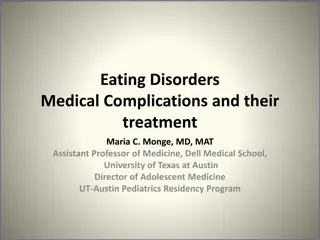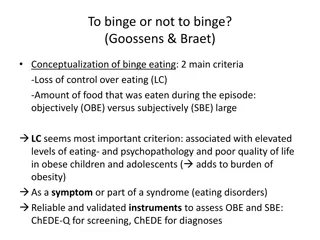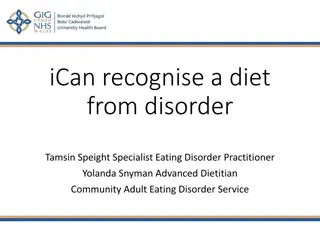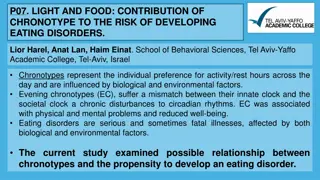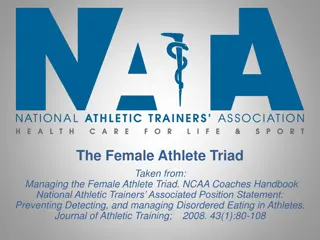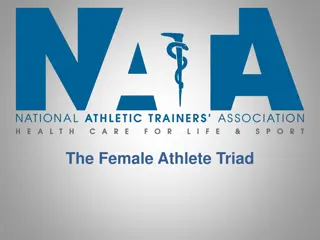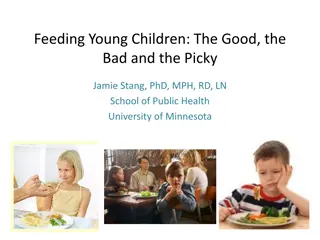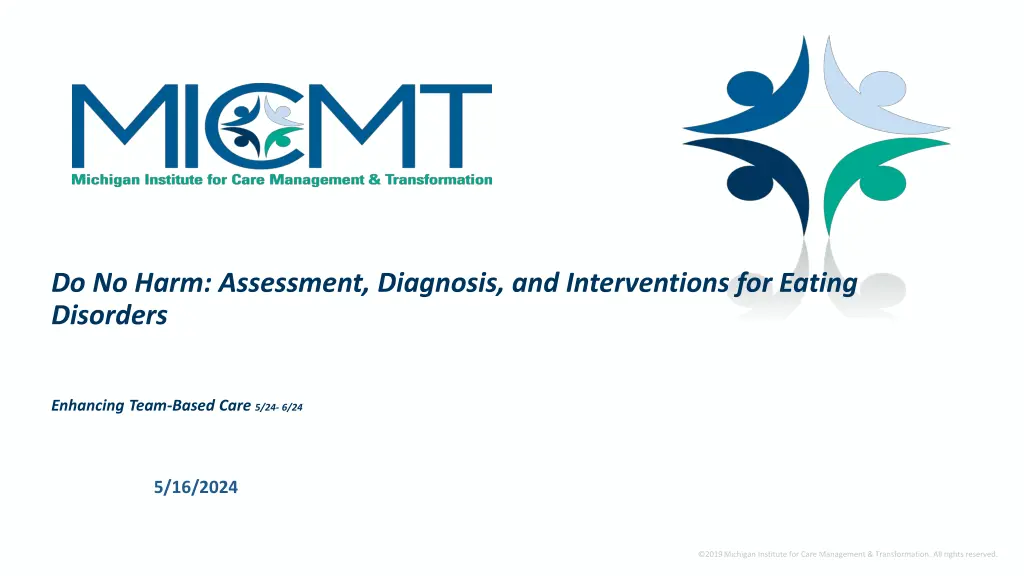
Enhancing Team-Based Care for Eating Disorders Webinar
Join the "Do No Harm" webinar series focused on assessment, diagnosis, and interventions for eating disorders, enhancing team-based care. Earn CE contact hours in nursing, social work, or as a registered dietitian. Explore team-based care strategies and learn about different eating disorder diagnoses, language use, psychiatric treatment referrals, and medication management.
Uploaded on | 1 Views
Download Presentation

Please find below an Image/Link to download the presentation.
The content on the website is provided AS IS for your information and personal use only. It may not be sold, licensed, or shared on other websites without obtaining consent from the author. If you encounter any issues during the download, it is possible that the publisher has removed the file from their server.
You are allowed to download the files provided on this website for personal or commercial use, subject to the condition that they are used lawfully. All files are the property of their respective owners.
The content on the website is provided AS IS for your information and personal use only. It may not be sold, licensed, or shared on other websites without obtaining consent from the author.
E N D
Presentation Transcript
Do No Harm: Assessment, Diagnosis, and Interventions for Eating Disorders Enhancing Team-Based Care 5/24- 6/24 5/16/2024
Enhancing Team-Based Care 5/24-6/24 Do No Harm: Assessment, Diagnosis, and Interventions for Eating Disorders No one with the ability to control content of this activity has a relevant financial relationship(s) to disclose with an ineligible company. Successful completion of the webinar includes: Attendance at the entire webinar - Live webinar attend with audio and see live slides Completion of the evaluation this will be sent to attendees Nursing: Upon successful completion of this live webinar the participant will earn 1.0 Nursing CE contact hour. Michigan Institute for Care Management and Transformation is approved as a provider of nursing continuing professional development by the Wisconsin Nurses Association, an accredited approver by the American Nurses Credentialing Center s Commission on Accreditation. Expiration date: 5/8/2026 Social Work: Upon successful completion of this live webinar the participant will earn 1.0 Social Work CE Contact Hours This course is approved by the NASW-Michigan CE Approving Body. Michigan Institute for Care Management and Transformation is an approved provider with the Michigan Social Work Continuing Education Collaborative. Approved provider number: MICEC 110216. Registered Dietitians: For today s live webinar, RDs can use the MICMT Nursing CE certificate for their CPEUs. See CDRnet core criteria for details https://www.cdrnet.org/core-criteria Note: This only pertains to RDs who attend the event live. Community Health Worker: For today s webinar, CHWs can use the MICMT certificate of completion for their CEUs. For details, access the Michigan Community Health Worker Alliance (MiCHWA) CHW Continuing Education Fact Sheet https://michwa.org/training/ 2
Learning Objective and Learning Outcome Learning Objective Describe team-based care strategies for integrating clinic and community-based resources for various team-based care roles (e.g. Nurses, Social Workers, unlicensed care team members such as Medical Assistants or Community Health Workers, Pharmacists, and Registered Dietitians). Learning Outcome Participants will gain knowledge about the team-based care model in the ambulatory care setting to address medical, behavioral, and/or psychosocial needs of patients which supports progress towards the patients health goals. 3
Presenters Presenters Amy VandenBerg PharmD, BCPP Clinical Associate Professor UM College of Pharmacy Clinical Specialist Psychiatry & Neurology Michigan Medicine Samantha Winnie, LMSW Clinical Social Worker Comprehensive Eating Disorders Program Michigan Medicine 4
At The Conclusion of this Session, Participants Will Be Able To: 1. Understand the differences between various eating disorder diagnoses 2. Learn helpful and unhelpful language to use when interacting with patients who have eating and body image issues and concerns 3. Establish confidence in psychiatric treatment referral process for patients with eating disorders 4. Describe how medications may be beneficial or detrimental when managing eating disorders 5
Eating Disorder: Range of Diagnoses Anorexia nervosa Under Ideal Body Weight Avoidant restrictive food intake disorder (ARFID) Bulimia nervosa Binge eating disorder Over Ideal Body Weight 6
Eating Disorders: Epidemiology Average Age at Onset/Diagnosis Lifetime Prevalence Annual Prevalence Adult vs Adolescent Anorexia Nervosa 14-15 years 3.6% W: 0.1% to 3.6% M: 0-0.3% W: 0 to 0.8% M: 0 to 0.2% W: Adult adolescent M: Adult < adolescent ARFID 11-14 years ~2 per 100,000 Bulimia 14-16 years 2.1% W: 0.3% to 4.6% M: 0.1% to 1.3% W: 0.3% to 2.2% M: 0 to 1.2% W: Adult adolescent M: Adult < adolescent Binge Eating Disorder Early 20s 2% W: 0.6% to 5.8% M: 0.3% to 2% W: 0.5% to 3% M: 0 to 1.2% W: Adult adolescent M: Adult > adolescent OSFED: Other Specified Feeding or Eating Disorder: Lifetime prevalence ~7% 7 Galmiche, 2019
Eating Disorders Risk Factors Transgender and gender diverse populations 20% to 50% endorse disordered eating patterns ~30% screen positive for EDO symptoms 2-12% diagnosed with EDO Biological Relative with EDO, type 1 diabetes Psychological Anxiety, depression, substance use disorder (chicken or egg?) Social Trauma, bullying 8 Keski-Rahkonene, 2023; nationaleatingdisorders.org 8
EDO Symptoms in Common Restriction Limit caloric intake Limit variety of foods Purging Induce elimination (emesis, laxatives) Exercise Binging Periods of excessive intake (may or may not be followed by purging) 9
Anorexia Nervosa (AN) Impaired perception of weight and body shape Obsessions about eating and gaining weight Common signs Cachexia, amenorrhea, edema, bradycardia, hypotension, callus on dorsum of hand, dental erosion Lab abnormalities K, Na, Cl, thyroid, PO4, Mg, PLT Typical 85% Ideal Body Weight Restricting and/or purging Atypical (not underweight) 10
Bulimia Nervosa (BN) Fluctuate between severe dieting and binge episodes Common Signs Dental erosion, callus on dorsum of hand, salivary/parotid gland enlargement, weight fluctuations Body image concerns Lab Abnormalities K, Cl, pH serum amylase May use purging for weight control 11
BN Binge eating High-fat and high- carb foods Frequent weight swings Laxative abuse Diuretic abuse Impulsivity Gastric rupture Dental erosion Parotitis Suicidality Vomiting Poor body image SUD Anxiety Lethargy Decreased concentration Abdominal pain Electrolye imbalances Preoccupation with weight Peripheral edema Perioral dermatitis Anemia Gastroparesis AN Calorie restriction Satiety dysfunction Excess exercise Disturbed sleep Amenorrhea Social withdrawal Emaciated Dry skin Fine body hair 12
Binge Eating Disorder (BED) Recurrent binge-eating episodes Eat beyond what most people would eat Rapid intake Lack of self-control No compensatory purging Common signs Significantly increased weight History of weight loss gain Lab Abnormalities lipids, glucose, A1c 13
Avoidant Restrictive Food Intake Disorder (ARFID) Dx criteria established DSM-5 (2013) previously EDO NOS Only EDO that does not include body image concerns Eating or feeding disturbance failure to meet nutritional needs Significant weight loss or failure to grow Nutritional deficiency Dependence on enteral feeding Three examples Lack of interest Sensory characteristics Concern about aversive consequences (choking, allergy) ~15% 14
Avoidant Restrictive Food Intake Disorder (ARFID) Bradycardia, QTc prolongation, lower bone mineral density, amenorrhea, micronutrient deficiencies Comorbidities (rates in patients with ARFID) Anxiety disorders up to 9% to 72% Depression 7% to 33% (lower than AN 20-48% or BN 23-80%) ASD 8% to 50% Flip side: ~20% of children with ASD considered high risk for ARFID 15 Sanchez- Cerezo, 2023
Who gets an eating disorder? Eating Disorders do not discriminate! People of all ages, backgrounds, and sizes can develop an eating disorder. Unfortunately, because there is still so much stigma about the characteristics of someone with an eating disorder, specifically anorexia, not everyone suffering gets the same treatment by healthcare providers. 16 16
Health At Every Size HAES A set of principles that serve as a roadmap for providers to be HAES-aligned. (not in order of importance) 1) Healthcare is a human right for people of all sizes, including those at the highest end of the size spectrum. 2) Care is fully provided only when free from anti-fat bias and offered with people of all sizes in mind. 3) Wellbeing, care, and healing are resources that are both collective and deeply personal. 4) Health is a sociopolitical construct that reflects that values of society. 17 17
Using inclusive and non-shaming language Instead Try: Avoid using: Unhealthy Focusing on the part of the body that you re concerned about & why Junk/Fattening/Bad Focusing on the specific nutritional content that you re concerned about & then speak about it neutrally Obese People in larger bodies People at a larger weight 18 18
Treatment settings Medical hospitalization/ inpatient Residential Partial hospitalization program (PHP) Intensive outpatient program (IOP) Outpatient 19 19
Treatment team Psychotherapist (social worker, psychologist, counselor) Medical provider (MD, NP) Dietitian (RD) Psychiatrist, specialized pharmacist (for medication management) 20 20
When to make a referral Eating and movement changes Examples: cutting out food groups, skipping meals, hiding/discarding food, eating large amounts of food in short periods of time, compulsive or excessive exercise Physical changes Examples: rapid or severe weight loss, bradycardia, hypotension, irregular or loss of menstrual cycle, stress fractures resulting from no or minimal trauma; for adolescents, not growing or gaining weight 21 21
Referral resources Guidelines for when a patient should be medically hospitalized (The APA and the Society for Adolescent Health Medicine) Residential treatment center Comprehensive outpatient team 22 22
FDA Approved Medications for EDOs AN none ARFID none BN only fluoxetine (Prozac) BED only lisdexamfetamine (Vyvanse) 23
Off-Label Medication Options for AN Antidepressants limited to no benefit for AN Primary role is for comorbid depression/anxiety Consider weight neutral options (SSRIs) Antipsychotics (aripiprazole, olanzapine, quetiapine, risperidone) Small studies, inconsistent results Questionable external validity Benzodiazepines Commonly used for anxiety related to food intake 24 Rodan 2023
Off-Label Medication With Failed Trials for AN Dronabinol (THC) Unexpectedly, associated with increased physical activity intensity Oxytocin Estrogen No direct effect on weight, some improvement in depressive symptoms Ghrelin/ralmorelin Omega-3 Tryptophan 25 Rodan 2023 25
Medication Considerations AN AVOID Stimulants Activating antidepressants (eg, bupropion, venlafaxine, duloxetine) TCAs cardiac risk Starting medications just because they cause wt gain CONSIDER Multivitamin Calcium/Vitamin D Zinc Selenium B12 Folic acid Dental health 26 26
Off-Label Medication Options for BN Antidepressants (primarily SSRIs) Reduce binge eating (up to 70%) and purging (~50%) Improve anxiety, obsessive symptoms, compulsive eating Benefits demonstrated in acute phase, not relapse prevention Improve outcomes independent of depressive symptoms Response considered 60% decrease in binge frequency at 3 weeks Others off label Topiramate reduced binge eating, purging at 10 weeks Lisdexamphetamine reduced binge eating episodes and compensatory behavior over 8 weeks 27 Rodan 2023
Medication Considerations for BN AVOID Antipsychotics that stimulate appetite (eg, olanzapine) Meds associated with impulsivity Aripiprazole, brexpiprazole Dopamine agonists (eg, ropinirole) CONSIDER Multivitamin Dental health 28 28
Off-Label Medication Options for BED Limited to No benefit SSRIs SNRIs Bupropion Armodafanil Orlistat Poorly tolerated Positive Evidence Methylphenidate Bupropion/naltrexone Decreased binge eating, depression and weight Topiramate 29 Rodan 2023
Medication Considerations for BED AVOID Appetite stimulants Antipsychotics, mirtazapine Meds associated with impulsivity Aripiprazole, brexpiprazole Dopamine agonists (eg, ropinirole) CONSIDER Statin Blood glucose management Metformin GLP-1 Agonists? 30 30
GLP-1 Agonists Appetite (increase satiety centrally) May decrease binge episodes BED assoc with changes GLP-1 levels Gastric emptying May further GI upset, abdominal pain Glucose production (liver) & Insulin sensitivity Improve glycemic control Cardioprotective May be beneficial with hyperlipidemia and other cardiac comorbidities 31 Balantekin, 2024
Medications Considerations for ARFID Primarily target comorbidities CONSIDER Acute risk of refeeding Nutritional supplements based on potential deficiencies Calcium/Vitamin D Electrolyte replacement For patients with enteral tubes Consider interactions with enteral feeds/nutritional supplements Consider liquid medications Antiemetics 32 32
References Balantekin KN, et al. The emerging role of glucagon-like peptide-1 in binge eating. J Endocrinol. 2024; JOE-23-0405 Galmiche M, et al. Prevalence of eating disorders over the 2000-2018 period: a systematic literature review. Am J Clin Nutr. 2019; 109: 1402-1413 Hilbert A, et al. Risk factors across the eating disorders. Psych Res. 2014; 220(1-2): 500-506. Kells MR, et al. Vitamin D and hypophosphatemia in patients with anorexia nervosa and avoidant/restrictive food intake disorder: a case control study. J Eat Disord. 2023; 11(1):195 Keski-Rahkonen, A. Eatind disorders in transgender and gender diverse people: characteristics, assessment and management. Curr Opin Psychiatry. 2023;36(6):412-418 Rodan, SC, et al. Pharmacotherapy, alternative and adjunctive therapies for eating disorders: findings from a rapid review. J Eat Disord. 2023; 11:112 Stoner SC, et al. Eating Disorders. In: DiPiro JT, et al. DiPiro s Pharmacotherapy: A Pathophysiologic Approach, 12th ed, McGraw Hill; 2023. Accessed May 14, 2024 33 33
MICMT Resources https://micmt-cares.org/ MICMT Contact: https://micmt-cares.org/contact 34
Disclaimer Each physician organization and/or practice is solely responsible for all medical care and services delivered to its patients and all decisions related to such medical care and services. Neither MICMT or the Regents of the University of Michigan shall be responsible for any delivery of medical care or other services to any patient, or any decisions, acts or omissions of persons in connection with the delivery of medical care or other services to any patient. 35

